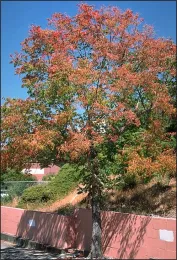
Trees normally begin to show fall colors in late October, especially after a several cold nights. If you are seeing orange, yellow, red, burgundy, and purple leaves on deciduous trees this time of year, it's a symptom of stress. You might not be able to do anything to correct the problem now, but much can be done to prevent a repeat next fall, and improve the health of your tree before spring.
First, determine the source of the stress and correct it. Look closely at the tree. Check for wounds on the trunk from mechanical injury or sunburn. If early fall color is the result of wounds, take steps to prevent further wounding. The trunks of young trees can be protected from string weeder damage with plastic sleeves. Better yet, place chip mulch on the soil around the tree to remove the temptation to mow or weed right up to the trunk.
Determine if the tree is growing in a site where the roots may be restricted by pavement or buildings. Is it possible the roots were recently cut? Root disease, recent disruption to roots from construction or grade changes, surface soil compaction from vehicles or foot traffic and girdling roots can also cause trees to develop early fall color. If surface compaction is a problem, loosen the soil by cultivating to a depth of 4 to 6 inches. This should improve moisture and oxygen penetration. Follow up by watering the tree deeply.

The best way to prevent stress and early fall color is to make sure the tree receives sufficient deep water during the summer. If you haven't already, deep water your tree. Sprinkler water does not provide adequate water for trees, so supplement with a hose, focusing the water underneath the tree canopy. For mature trees, water needs to penetrate to a depth of 12-18" to provide enough water.
For questions about your trees, contact the Master Gardeners at (209) 525-6862 or fill out this form http://ucanr.edu/ask/ucmgstanislaus
Ed Perry is the emeritus Environmental Horticultural Advisor for University of California Cooperative Extension (UCCE) in Stanislaus County where he worked for over 30 years.

